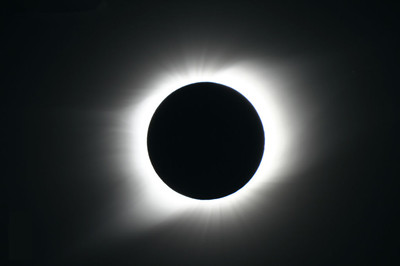Eclipses are supposed to make things go dark: the moon blocks the sun, and day turns to night.
日月食一直被认为是使得事物蒙上一层黑色:月亮挡住了太阳,因此白天变成黑夜。
Now astronomers have accidentally discovered the opposite: an eclipse that makes a star brighter.
现在天文学家们偶然间发现了截然不同的情况:日月食会使一颗恒星变的更加明亮。
Thank Einstein. And Kepler—the space telescope, not Johannes.
多亏了爱因斯坦。 还有天文望远镜开普勒,不是德国那位天文学家。
Launched in 2009, Kepler watched more than 100,000 stars, looking for tiny dips in a star's brightness caused by orbiting planets when they pass in front of their sun.
2009年启用的开普勒望远镜根据恒星运动到太阳前方附近轨道时造成恒星反射的微弱光观察到了超过10万颗恒星。
But one star didn't get the memo.
但有颗星则没有按规矩出牌。
Every 88 days, it brightens slightly.
每88天,它就会变亮一点。

Researchers realized that they were actually seeing a binary star system.
研究人员们意识到他们实际上是在观察一颗双子星系统。
One of the pair is big and bright like our sun.
其中一颗是像我们的太阳那样又大又明亮。
The other is a white dwarf—a small, dim star a little larger than Earth, but so dense that a spoonful weighs tons.
另一颗是白矮星—一种小型,昏暗,比地球稍大点的恒星,但密度极高,一汤匙的物质就有几吨重。
Because of its high mass, when the white dwarf passes in front of its mate its gravity bends and amplifies the larger star's light, just as Einstein said.
由于其高密度,当这颗白矮星运动到它同伴的前面时,自身重力发生弯曲并使得较大的那颗恒星发出的光线被增强,就如同爱因斯坦曾经描述的那样。
In other words, the white dwarf acts like a lens that makes the bigger star appear brighter during the eclipse.
换句话说,白矮星充当了透射镜片的作用,使得在日月食现象时较大的恒星候变得更加明亮。
The report is in the journal Science.
这一研究报告已在《科学》杂志上发表。
Black holes that orbit stars should do the same thing.
黑洞附近的恒星也能造成同样的现象。
So someday someone might find a black hole by looking for the light.
所以终有一天有人会通过寻找光从而发现一个黑洞。












